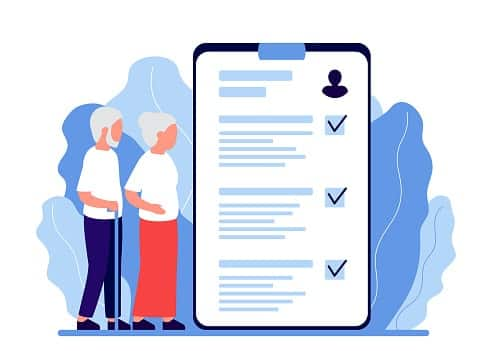What is an advance premium tax credit?
A premium tax credit is a federal credit that you can claim to help decrease your monthly costs for health insurance. It’s designed to help eligible individuals and families with lower income afford a health care plan purchased through the health insurance marketplace (at Healthcare.gov).
"If an individual or family qualifies for this credit, the amount of the credit can be used to reduce your marketplace plan premium," says Matthew Brust, an associate attorney with Henderson Franklin Starnes & Holt.
You can use the amount of premium tax credits to pay premium costs upfront. This is when a premium tax credit is referred to as an "advance premium tax credit."
Premium tax credit eligibility expanded
Traditionally, the premium tax credit was only offered to those with household income below 400% of the federal poverty level (except in California, where the threshold was 600%). But the recently passed American Rescue Plan Act of 2021 expanded these tax credits and increased credit amounts for two years (through the 2022 marketplace plan year).
As a result, for example, a household of four earning $50,000 may be able to claim a credit of approximately $16,500 -- around $2,200 more than before.
How does an advance premium tax credit work?
If you qualify for the credit via the health insurance marketplace, the credit amount can be paid in advance directly to the insurance company to lower your monthly premium payments. You can opt to have all, some, or none of the estimated credit paid in advance.
When applying for coverage at the marketplace, you will estimate your expected income for the year. If you’re eligible for a premium tax credit based on your estimate, you can use any amount of the credit in advance to lower your premium.
"If by the end of the year, the amount you've used as an advance premium tax credit is more than what you should have taken based on your final annual income based on your final income, you will be required to pay back the excess when you are filing your annual tax return. If the amount used is lower than what you qualify for, you will be paid back the difference in the form of a tax refund," explains Greg Rozdeba, president of Dundas Life.
Change in requirement to repay excess payments
The rules have recently changed for the 2020 premium tax credit. The American Rescue Plan Act of 2021 suspended the requirement to repay advance payments of the premium (only for tax year 2020) when filing your Form 1040.
If you choose to use the premium tax credit this year, note that you will have to file tax form 8962 with your next federal income tax return. IRS Form 8962 premium tax credit is what you use to claim or reconcile the tax credit.
How to apply for the advance premium tax credit
Qualification is based on your estimated annual income. After entering this amount on the Healthcare.gov website while applying for coverage, the marketplace determines your eligibility automatically. It calculates the amount of premium tax credit you may be able to claim for the tax year.
"If initially, the marketplace determines that you are not eligible to receive the credit, you can file tax form 8962 to indicate that circumstances have changed and that you now qualify for the credit," Brust adds.
How to calculate the advance premium tax credit
The amount of the credit is typically equal to the premium for the second-lowest-cost silver plan available through the health insurance marketplace minus a certain percentage of your household income.
"It's the difference between the second-lowest silver plan and the highest amount that your state has reasoned to be affordable as a monthly health insurance premium," notes Adam Garcia, a personal finance and investing expert and founder of TheStorkDork.com. "This is also known as the premium cap."
Here's an example:
- Let's say a person makes $25,000 a year.
- He expects to pay 10% of his income (or $2,500) to health insurance premiums.
- His benchmark plan is $5,000.
- In this case, the person would be eligible for a $2,500 credit, which you get by subtracting the benchmark plan with the percentage of income expected to get paid on health insurance premiums.
Be aware that the advance premium tax credit can’t be more than the cost of the premium for the marketplace plan.
Frequently asked questions
What is an excess advance premium tax credit?
An excess advance premium tax credit is the amount that exceeds your eligible premium tax credit.
When you complete your federal tax return, you will compute the credit and compare it to the amount of the advance premium tax credit you claimed. If the actual allowable credit on your return is less than the advance premium tax credit, this difference -- subject to repayment caps -- will be subtracted from your refund or added to the balance due (except for tax year 2020).
But if your actual allowable credit is greater than the advance premium tax credit, the difference will be added to your refund or subtracted from the amount due. You must pay excess advance payments.
How do I know if I qualify for the advance premium tax credit?
If you apply for insurance through the health insurance marketplace, the marketplace website will automatically determine if you’re eligible or not based on the amount of estimated income for the year that you indicate.
Per the IRS, you may qualify for an advance premium tax credit if you’re within certain income limits and if you or a family member enrolled for health insurance coverage through the marketplace for at least one month of a calendar year in which you or they were not eligible for affordable coverage through an eligible employer-sponsored plan that provides minimum value or eligible to enroll in government health coverage (like Medicare or Medicaid).
Also, your health insurance premiums for at least one of those same months must be paid by the original due date of your tax return, either through advance credit payments, by you, or by someone else. Other rules apply, too.
Where can I use an advance premium tax credit?
The premium tax credit you’re eligible for can be used in advance to offset your health insurance marketplace plan premiums.
This means your insurance company is paid directly in advance with some or all of your premium tax credit, depending on how much you choose to apply toward your premiums.




